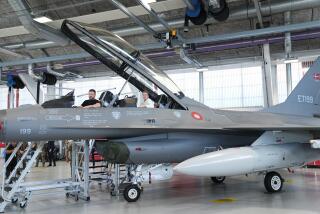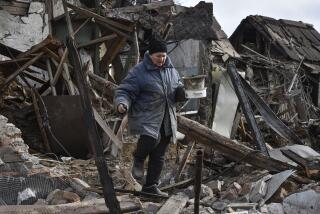Land Battle Poses New Risk to Pilots : Air attack: They would be forced to fly lower and slower in support of allied ground troops.
- Share via
EASTERN SAUDI ARABIA — Despite the unchallenged allied air supremacy over Iraq, providing close air support for hundreds of thousands of advancing troops in a fast-paced ground war is likely to prove much more difficult than the air battle so far.
Pilots say they would be forced to fly lower and slower to avoid killing their own troops, exposing themselves to hundreds of deadly antiaircraft batteries and surface-to-air missiles believed to be still hidden across Iraq and Kuwait.
“There’s a whole lot more pressure,” said one Navy A-6E Intruder pilot aboard the carrier America. “And the risks are definitely greater.”
“It’s going to be scary,” agreed another A-6E pilot. “It’s going to be scarier than it is now. And I’ve already been to heavily defended targets where I didn’t think I was coming out.”
Allied pilots have avoided a higher casualty toll--only 50 aircraft have been lost in 37 days and more than 91,000 sorties--because those on bombing sorties usually dip only once per mission to quickly drop their bombs in what the pilots call “one pass, haul ass” air strikes.
That will change if allied troops storm across the border, the front lines begin constantly shifting and battlefields are shrouded in thick smoke from exploding ordnance and burning oil-filled ditches that the Iraqis are expected to torch to slow the assault.
“Right now, they’re (Iraqi air defense crews) not poking their heads out of the ground very much,” said the A-6E squadron leader, Cmdr. Lou Crenshaw of Virginia Beach, Va. “But when (an air crew) is being called out to help somebody, that means they’re out of their holes, they’re moving around, got their hand-held SAMs and are pulling out all the stops.”
The use of heavy air support to pound Iraqi forces during a ground attack also inevitably increases the odds that allied pilots will accidentally kill allied troops. Already, many of the 19 Americans that the Pentagon confirms as killed in action have been victims of so-called friendly fire from U.S. planes and helicopters.
“Before I drop a string of bombs, I need 100% knowledge that I’m not going to kill my own guys,” said the second A-6E pilot. “And that just means we’re going to be hanging it out on the line a lot more, taking a lot more risks.”
The risks may be compounded since the allied forces include armies from 16 nations, some speaking the same language and using equipment similar to Iraq’s. Coordination will be key: The battle plan appears to be the most ambitious attempt to synchronize a massive ground attack with amphibious landings, close air cover and naval bombardment since World War II’s D-Day.
Also, the very success of the devastating air war so far already poses a new danger: Allied pilots must spend longer in the air to find increasingly scarce targets in many areas.
“The last five or six (allied) guys shot down would not have been shot down if they hadn’t stayed longer looking for targets,” said Maj. Steven Looney, a U.S. Air Force F-16 pilot at an air base in northern Saudi Arabia. “If they had just dropped their bombs and left, (the Iraqis) wouldn’t have known they were there.”
Despite the obvious damage that the Air Force is inflicting, Looney, 33, of Pinedale, Wyo., said the Iraqis have steadily improved their ability to conceal weapons and vehicles.
“They’re working harder at disguising and hiding them . . . ,” he said.
As a result, “Now we’re spending a lot more time in the air looking for targets.”
And while pilots say Iraqi antiaircraft fire has decreased steadily since the war began Jan. 17, they are still sometimes surprised by the intensity of the fire.
“Sometimes you’re out there, they’re putting out a lot of missiles and antiaircraft fire,” said Lt. Col. Ron Kurtz, 43, from Harrodsburg, Ky. “Other days, you’re uncontested.”
Depending on how long the war lasts, weather also may make flying more dangerous. On Wednesday, allied forces in northern Saudi Arabia were whipped by a blinding shamal, a harsh introduction to the annual sandstorm season.
The giant clouds of whirling dust, gusting up to 75 m.p.h., can halt convoys, disable equipment and ground some aircraft. They can also increase the chances of allied forces shooting at each other in the confusion.
It also forces many attack aircraft, such as the tank-killing A-10 Warthog jets and Apache helicopters, to fly closer to their targets and possible antiaircraft fire.
For now, Crenshaw and the other Navy pilots aboard the America say they are astonished at the damage they can see, even from 15,000 feet. Crenshaw described southern Kuwait as a moonscape of burned-out tanks, artillery batteries, fuel depots and munitions dumps, all veiled by black smoke from burning oil wells that covers the earth for miles around.
“Whenever I look down there and see the pounding they’re taking, I just can’t believe it,” Crenshaw said. “It’s just unbelievable (Saddam Hussein) has allowed that to happen to his own people. It’s inconceivable. He should be hanged just for that.”
This report was based on pool reports reviewed by military censors.
More to Read
Sign up for Essential California
The most important California stories and recommendations in your inbox every morning.
You may occasionally receive promotional content from the Los Angeles Times.











